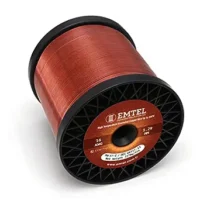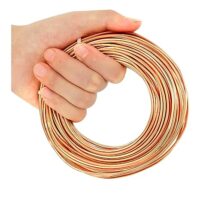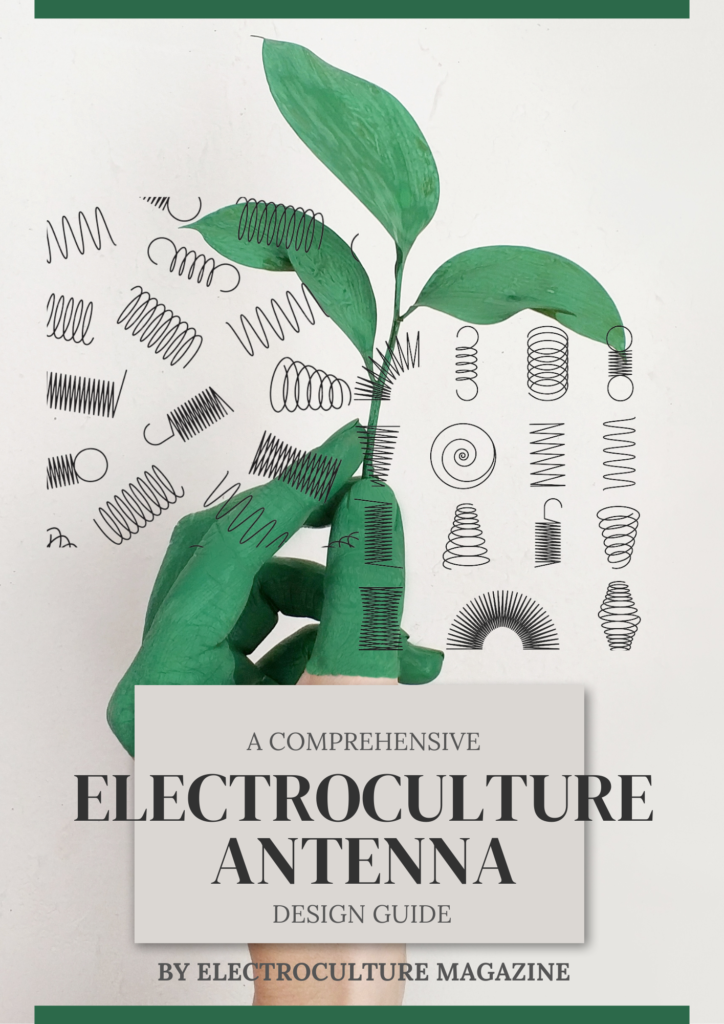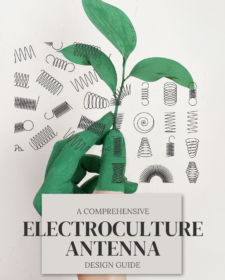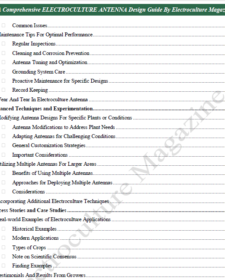Welcome to the world of electroculture antennas! In this comprehensive guide, we will explore the fascinating concept of electroculture antenna and provide you with the knowledge and resources to design and build your own DIY electroculture antenna. Whether you are a gardening enthusiast or a professional farmer, electroculture antennas offer a unique opportunity to boost plant growth and increase yield. So, let’s dive in and discover the wonders of electroculture technology!
Key Takeaways:
- Electroculture antennas can be designed and built as DIY projects.
- Designing and building your own electroculture antenna allows for customization and optimization.
- Different types of electroculture antennas exist, each with its own potential benefits for plant growth.
- Electroculture antenna design can be optimized by considering factors like shape, size, and material choices.
- Incorporating innovative design tips can enhance the efficiency and effectiveness of your electroculture system.
Learn All About Electrcoutyre Antenna Design, Get Our Comprehencive eBook
DIY Electroculture Antenna: Step-by-Step Instructions for Building Your Own
In this section, we will guide you through the process of building your own DIY electroculture antenna. By following these step-by-step instructions and utilizing the provided list of materials and tools, you’ll be able to construct an effective antenna that harnesses the power of electroculture technology.
Before we begin, it’s important to understand the benefits and principles behind electroculture. This innovative agricultural technique aims to enhance plant growth and productivity by utilizing electrostatic fields. By integrating an electroculture antenna into your garden or farm, you can potentially boost crop yields, improve plant health, and increase nutrient absorption.
Now, let’s dive into the process of building your DIY electroculture antenna:
Gather the Required Materials and Tools
Before you start constructing your electroculture antenna, make sure you have the following materials and tools:
- Wire – preferably copper wire
- Insulating material – such as PVC pipe or rubber tubing
- Electric fence energizer – provides the necessary power supply
- Alligator clips – for connection purposes
- Screws, bolts, and nuts – for securing the antenna
- Wire cutters
- Wire strippers
- Drill and drill bits
With these materials and tools at hand, you’re ready to move on to the next steps.
Construct the Electroculture Antenna
Follow these step-by-step instructions to build your DIY electroculture antenna:
- Measure and cut the wire to the desired length. This will depend on the size of your garden or agricultural area.
- Strip the insulation off both ends of the wire, exposing the bare copper.
- If using PVC pipe or rubber tubing, cut it to match the length of the wire.
- If using a PVC pipe, secure the wire and insulating material inside it using screws, bolts, and nuts.
Optimize Antenna Performance
Once you have constructed your electroculture antenna, it’s crucial to optimize its performance for maximum effectiveness. Consider the following tips:
Ensure the antenna is positioned vertically, securely anchored to the ground, and elevated above vegetation for optimum coverage.
Connect the alligator clips to the electric fence energizer, following the manufacturer’s instructions for proper installation.
Regularly inspect the antenna for any signs of damage or wear, and make necessary repairs or replacements as needed.
Monitor and adjust the intensity of the electrostatic field based on the specific requirements of your plants and growing conditions.
By implementing these optimization techniques, you can ensure that your DIY electroculture antenna operates at its full potential.
Now that you have learned the step-by-step process of building your own electroculture antenna and optimizing its performance, you are ready to tap into the potential of electroculture technology. Exciting opportunities await as you explore the world of DIY electroculture antennas and witness the remarkable impact they can have on your plants’ growth and overall agricultural practices.
Innovative Design Tips for Electroculture Antenna
In this section, we will explore innovative design tips to enhance the efficiency and effectiveness of your electroculture antenna. By incorporating these design elements, you can optimize plant growth and maximize the benefits of electroculture technology. Let’s dive in:
1. Antenna Shape:
Consider experimenting with different antenna shapes to achieve better results. While a straight wire antenna is commonly used, try exploring alternative shapes such as loops or spirals. These variations can provide different electromagnetic field distributions, influencing plant growth patterns.
2. Antenna Size:
The size of your electroculture antenna plays a crucial role in its effectiveness. Generally, larger antennas have higher capacitance and inductance, which can enhance the electromagnetic field strength. However, it’s essential to strike a balance and ensure that the antenna size is suitable for your specific gardening or agricultural setup.
3. Material Choices:
Experimenting with different materials for your electroculture antenna can yield varying results. Copper wire is commonly used due to its excellent conductivity, but you can also explore materials like aluminum or stainless steel. Additionally, consider coating the antenna with insulating materials to reduce interference and improve performance.
4. Grounding:
Proper grounding is crucial for the optimal functioning of your electroculture antenna. Ensure that the antenna is adequately grounded, preferably using a grounding rod or plate. This helps eliminate unwanted external signals and ensures a stable electromagnetic field for your plants.
5. Distance and Placement:
The distance and placement of your electroculture antenna can significantly impact its effectiveness. Experiment with different distances from the plants to find the optimal position. Additionally, consider the height and orientation of the antenna for maximum exposure to the plant canopy.
Expert Tip: Remember to document your design experiments and observations to track the impact of each design variation on plant growth. This will help refine your electroculture antenna design over time.
By implementing these innovative design tips, you can take your electroculture antenna to the next level, improving plant growth and harnessing the full potential of electroculture technology.
Learn All About Electroculture Anetnna Design, Get Our Comprehensive eBook Now…
Conclusion
In conclusion, electroculture antennas offer an intriguing approach to boost plant growth. By following our comprehensive guide for DIY electroculture antenna design and incorporating innovative design tips, you can harness the potential of electroculture technology for your own garden or agricultural practices.

Whether you are a gardening enthusiast or a professional farmer, electroculture antennas provide a unique opportunity to enhance plant growth and increase yield. By utilizing this exciting technology, you can unlock the full potential of your plants and achieve remarkable results.
Start exploring the world of electroculture today and witness the transformative power it holds for your crops. With the right design and implementation, you can create an environment that nurtures healthy and thriving plants, leading to bountiful harvests and a greener future.
FAQ
What is an electroculture antenna?
An electroculture antenna is a device designed to harness and amplify electromagnetic energy to enhance plant growth. It is based on the concept that plants can absorb and utilize electromagnetic energy for various physiological processes.
How does an electroculture antenna work?
An electroculture antenna works by capturing and transmitting electromagnetic radiation to plants. This radiation stimulates plant cells, promoting photosynthesis, nutrient uptake, and overall growth. The antenna acts as a conductor, amplifying the energy absorbed from the atmosphere and delivering it to the plants.
What are the benefits of using an electroculture antenna?
Using an electroculture antenna can result in several benefits, including accelerated plant growth, increased crop yield, improved plant health and resistance to pests and diseases, reduced water consumption, and enhanced nutrient absorption. It offers a sustainable and environmentally friendly approach to agriculture and horticulture.
Can I build my own DIY electroculture antenna?
Yes, you can build your own DIY electroculture antenna. In fact, constructing your own antenna can be a cost-effective and rewarding project. By following step-by-step instructions and obtaining the necessary materials and tools, you can create a customized electroculture antenna tailored to your specific needs and garden size.

Are there different types of electroculture antennas?
Yes, there are different types of electroculture antennas. Some common types include pyramid-shaped antennas, cone-shaped antennas, and spiral antennas. Each design has its own unique attributes and potential benefits. It is important to choose a design that suits your specific requirements and garden setup.
What materials and tools do I need to build a DIY electroculture antenna?
To build a DIY electroculture antenna, you will need materials such as copper wire, PVC pipes, connectors, grounding rods, and insulating materials. Additionally, you will need basic tools such as wire cutters, pliers, drills, and measuring instruments. Detailed instructions and a comprehensive materials list can be found in the DIY electroculture antenna section.
Can I optimize the performance of my DIY electroculture antenna?
Yes, you can optimize the performance of your DIY electroculture antenna by considering various factors. These include antenna placement, height, orientation, and grounding. Additionally, experimenting with different sizes and shapes, as well as incorporating innovative design tips, can further enhance the efficiency and effectiveness of your electroculture antenna.



